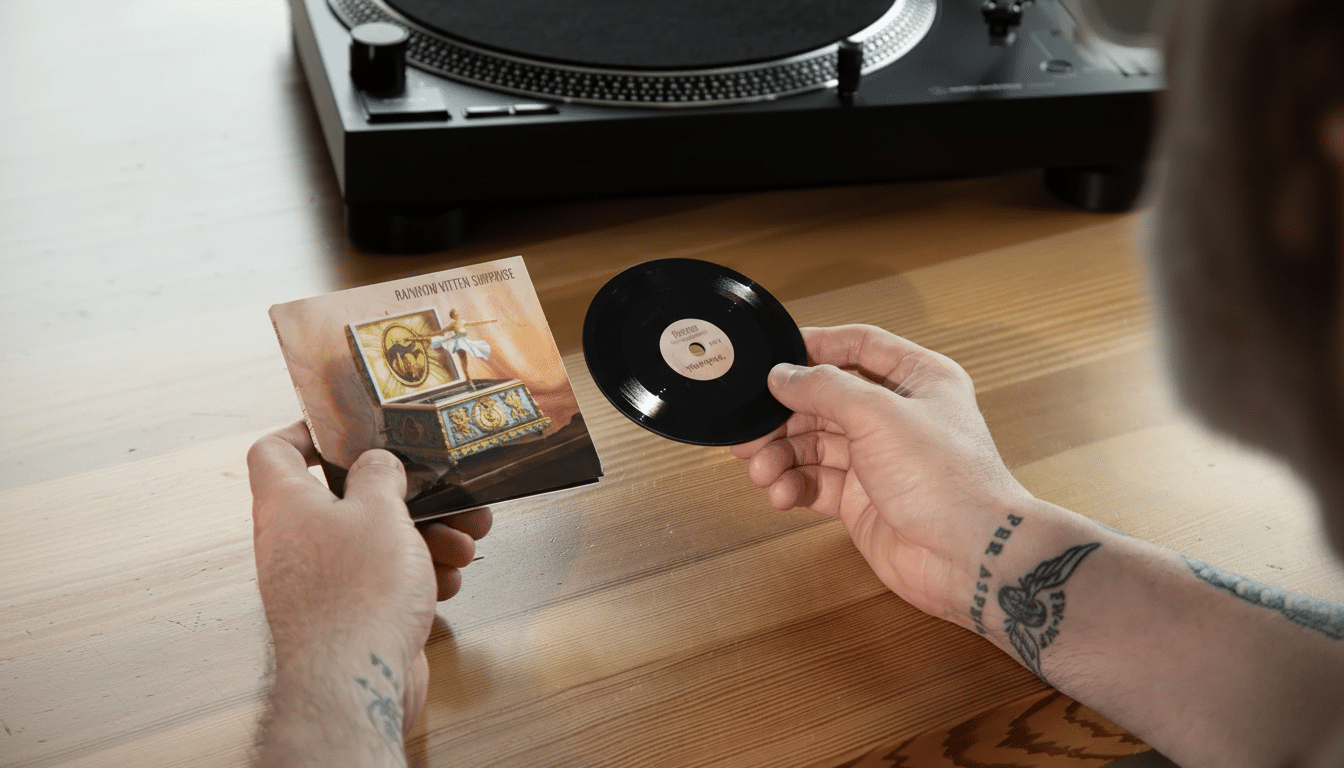Tiny Vinyl is the latest spin on the analog revival, reducing the LP experience to a 4-inch disc that will actually play on any regular 33 rpm turntable.
It’s a novelty, it’s clever engineering and — it appears, anyway — collectors, aficionados, and gift shoppers are all really excited about them.
- What Is Tiny Vinyl? Inside the 4-Inch Microgroove Format
- How They Work on Turntables: Setup and Playback Tips
- What to Expect from Sound: Performance on 4-Inch Discs
- Collectibility and Retail Push: Limited Runs and Exclusives
- Smaller Footprint Claims: Materials and Sustainability
- Why It Matters in the Vinyl Boom: Access and Ritual
- Buying Tips for Tiny Vinyl: Setup, Care, and Sourcing

Think back to pocketable music toys; this is the grown-up, hi-fi cousin. Not little plastic trinkets, these mini records are actual microgroove pressings that have been cut to vinyl and packaged like diminutive singles.
What Is Tiny Vinyl? Inside the 4-Inch Microgroove Format
Each Tiny Vinyl is a 4-inch record set to play at the common 33 1/3 rpm speed with a standard spindle. Due to mastering and groove space, the format can contain only one track on each side, often a single edit. The company stamps a distinct TV number on the packaging to identify production runs — a nod to vintage pressing IDs that also helps collectors keep track of variants.
The discs come in protective sleeves like shrunken 7-inches, occasionally accompanied by artwork and credits. Though the form factor is cute, the format is legitimate: the turntable’s stylus rides a true microgroove rather than an imitation track.
How They Work on Turntables: Setup and Playback Tips
Most belt- and direct-drive turntables should be capable of playing Tiny Vinyl without any mods, as long as they have a 33 rpm speed setting and a regular tonearm with adjustable tracking force. Because the record is small, cueing might feel more delicate — use a steady hand, the cue lever, and a grippy mat so the disc won’t slip on a full-size platter.
Auto-return mechanisms, platter sensors, and very heavy tracking forces can be fussy with odd sizes. If the deck is inclined to raise the arm too early on short records, manual mode is preferable, if available. The safe starting position for most systems is with the cartridge tracking around 1.5–2 grams.
What to Expect from Sound: Performance on 4-Inch Discs
Physics sets the boundaries here. At 33 rpm — compared to 45 and 78 — groove velocity on four-inch discs is considerably slower (about a quarter to a third of that at the outer edge), so engineers cut with conservative levels and EQ to keep distortion and inner-groove artifacts down. The result is a cute, surprisingly listenable presentation most effectively served with single tracks rather than epic dynamics.

You get the character of the song with moderate volume and bass compared to larger formats, especially on a well-set-up turntable. Surface noise can be more evident on a tiny canvas like this, so clean handling and anti-static sleeves are paramount.
Collectibility and Retail Push: Limited Runs and Exclusives
Tiny Vinyl is doubling down on limited runs and pop-up-centric curation. A big-box retailer has its own line of exclusive Tiny Vinyl titles, pressed on 4- to 5-inch records by high-profile artists, showcasing how easy it is for the format to be stumbled upon in the aisles of a weekend shopping spree. Those exclusives don’t sell elsewhere — adding scarcity, and a straight path for gift buyers.
That package numbering also acts as a quasi mini-pressing code, which may become important later. Collector marketplaces like Discogs often list price premiums for short-run, artist-specific variants; Tiny Vinyl’s micro-pressings slot into that model nicely. Look for collaborations, colorways, and seasonal drops to drive demand.
Smaller Footprint Claims: Materials and Sustainability
Each Tiny Vinyl weighs 15 grams, versus about 140 for a standard LP — a material savings of about 89% by weight, the company says. The discs are 100% bio-attributed vinyl, which is a mass-balance approach where the renewable feedstock provides input to the final product. In the plastics industry, these claims are often audited by initiatives like ISCC PLUS.
The environmental impact is about more than just disc weight — packaging and shipping density, as well as the production energy footprint, matter too — but smaller pressings can mean fewer kilograms of shipping emissions per unit and less raw PVC use. For listeners who enjoy physical music but prefer a lighter materials load, the format is an admirable step forward.
Why It Matters in the Vinyl Boom: Access and Ritual
For years now, vinyl has been a bright spot in physical music. The Recording Industry Association of America said top-level revenue figures for vinyl increased in 2023, comprising around 72% of all physical music earnings in the United States. Luminate’s count is about 49.6 million vinyl records sold in the U.S. last year, and reflects musically inclined hipsters’ continued hunger for a more physical listening experience — something they can hold in their hands.
Tiny Vinyl seizes on that momentum while lowering the bar of entry. It’s inexpensive, giftable, and immediately displayable, but also demands an actual turntable — and so it keeps the attendant ritual in place. For artists and labels, it’s a new format to send out to fans, where the various ephemera of merch and music connect.
Buying Tips for Tiny Vinyl: Setup, Care, and Sourcing
- Ensure your turntable supports 33 rpm play and manual cueing.
- Keep the stylus clean and use a flat mat, with low tracking force.
- Store the discs vertically in sleeves; if you’re obsessive about “first runs,” remember that TV number.
- For exclusives, watch shop announcements and artist channels — they often sell out quickly.

